Flying Class One
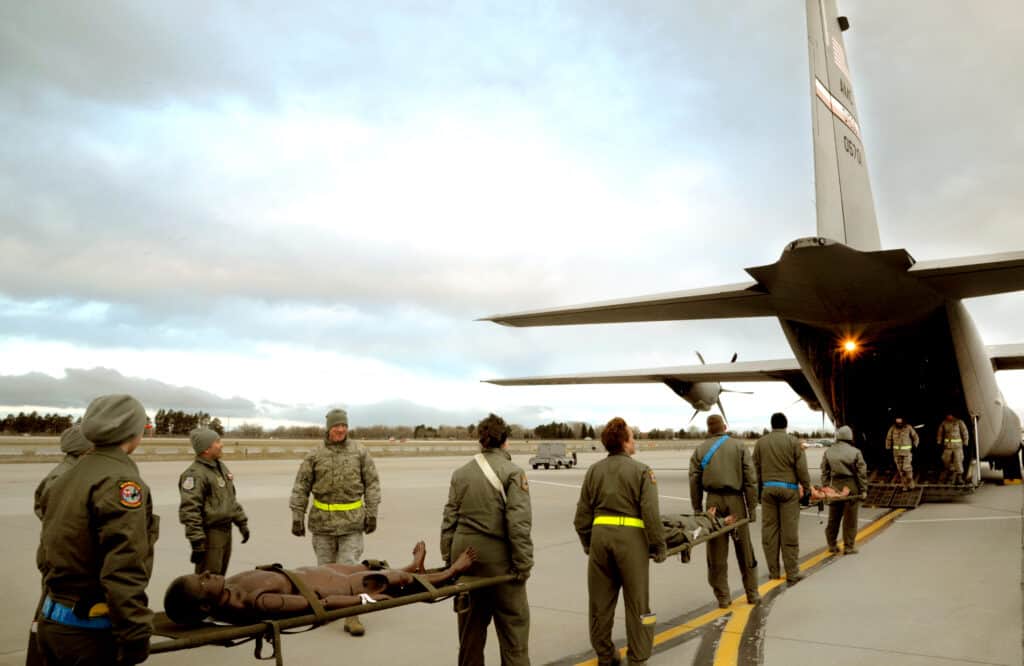
This article is intended to give a comprehensive recap of what your time may look like at Wright-Patterson Air Force Base (WPAFB) while conducting your Flying Class One (FC1) wether that be with the Air National Guard (ANG), Air Force Reserves (AFRC), Active Duty (AD) or through a university commissioning source such as United States Air Force Academy (USAFA) or Reserve Officers’ Training Corps (ROTC). This article is written and is current as of October of 2023.
Pre-Departure
If you’re a Guard or Reserve selectee, a lot of your hard work on the forefront in regards to testing, applications, rushing and interviews leads to this trip. This is also likely the only obstacle that sits between you and OTS dates. If you’re an off-the-street hire from a Guard or Reserve unit, this very well could be your first time on military orders, so enjoy it!
Another note for off the street hires: If you’re able, get a Common Access Card (CAC Card) prior to your Flying Class One. Having a CAC card will make your life significantly easier getting on base and around Wright-Patterson Air Force Base.
If you’re an Active Duty or ROTC bubba, this trip will look slightly different for you compared to the Guard / Reserve folks including a more structured trip, no rental car, most meals coming from a white cardboard lunch box or the DFAC, and a sprinter van that you’ll pile into for trips to and from the respective sides of Wright-Patterson Air Force Base with the other cadets / selectees.
Day 0:
Day 0 starts on a Sunday with a flight from your home of record to Dayton, OH. Dayton’s airport is rather underwhelming, but everyone there is super helpful. The airport also gets a lot of government contractors and military personnel traffic, so they can help you if needed.
After you land, ROTC and AD candidates will more than likely have to either Uber or taxi, while the Guard and Reserve selectees can drive themselves with a rental car (if your unit sets you up in a rental). Regardless of how you get there, find your way from the airport to the historic Wright-Patterson Inn at 2439 Schlatter Dr. Bldg. 825, Area A Wright-Patterson AFB, Ohio 45433. The Inn isn’t anything to write home about, but it’s special in its own way. Once you check in and get settled, it’s good to reflect over the crimson red comforter, yellow tiled bathroom and old hotel carpet while thinking about all the other pilots that have gone through these same steps en-route to acquiring their wings!
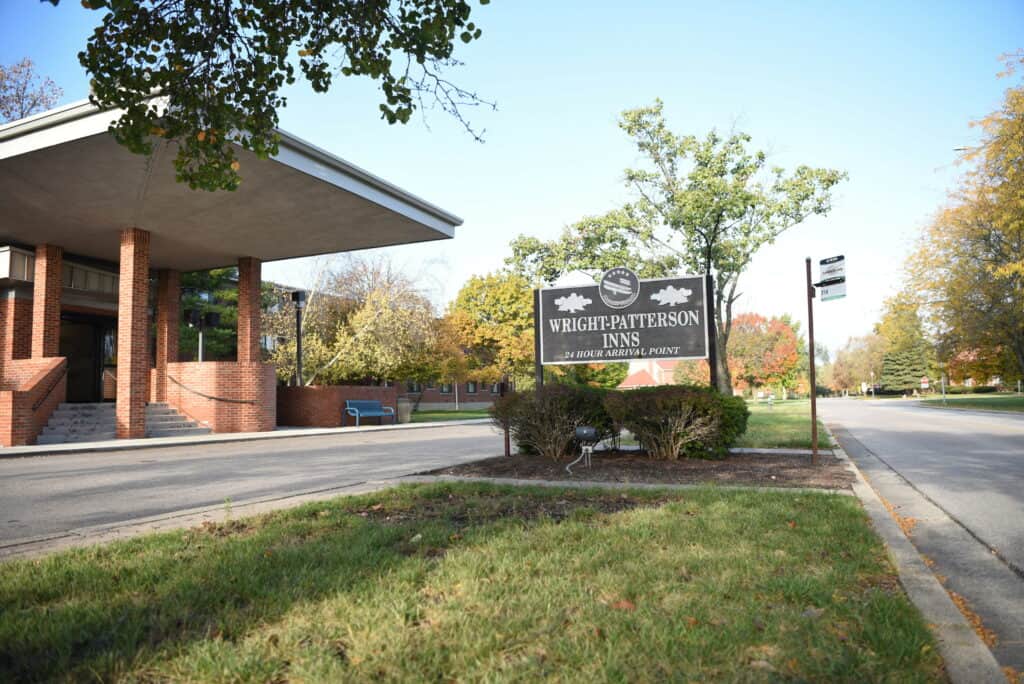
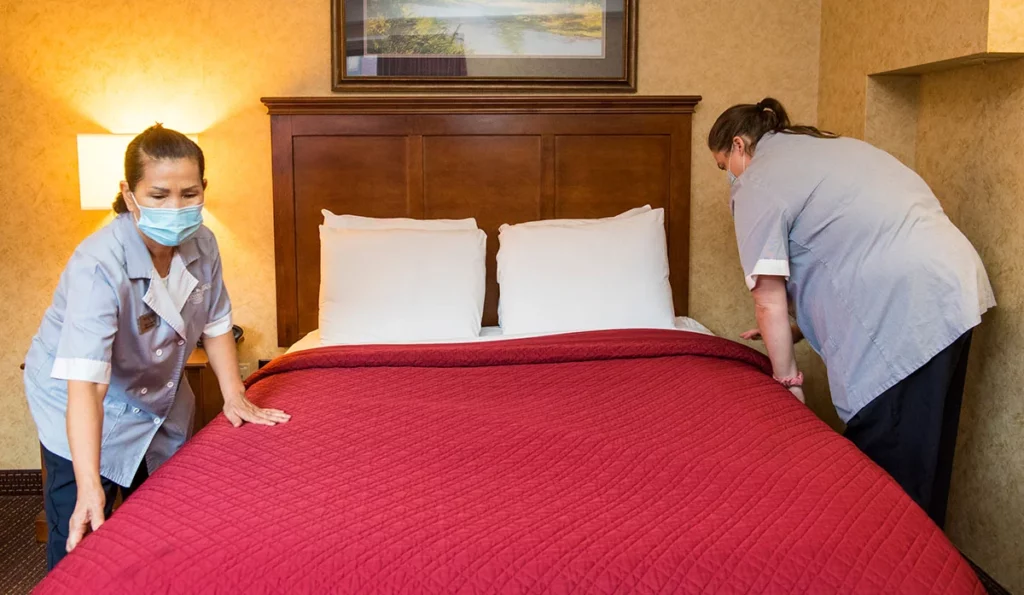
Try and call it an early night. If you’re in the pre-assigned Group A (you will receive this assignment via email the week prior) start fasting at 7 PM, and prepare for giving 12 vials of blood and a urinalysis bright and early in the morning by drinking lots of fluids. If you’re a part of Group B, eat as late as you want but it’s also wise to start drinking water in preparation for the next few days.
Overall disclaimers relevant for all days at your FC1:
Things worth bringing with you every day:
- A pen to sign and fill out medical documents
- Some snacks (something like peanut butter crackers does well at holding you over until lunch after giving blood or if some of your exams dig into your lunch hour)
- A good book (there is no reception in the waiting room)
- Sunglasses (at some point you’ll have your eyes dilated so sunglasses are a must)
- Your prescription glasses
What to wear: They say to dress business casual if you are an off-the-street hire. Khaki pants or chinos and a collared shirt or button down works great!
Things to consider: Everyone at Wright-Patt is there to help you on your way to becoming a pilot. Although it’s a stressful time, ensure you treat everyone with the utmost respect. No one is out to get you.
Day 1:
Group A will head right across the street from the Inn to a large medical building called “Wright-Patterson Medical Center” for the aforementioned blood draw and urinalysis. (This building is located at 4881 Sugar Maple Dr, Wright-Patterson AFB, OH 45433)
If I remember correctly, show time was 6:45 AM. Show up, check in, drink water and wait your turn. You’ll get called back and likely take blood prior to doing your urinalysis. The blood draw room is no bigger than 10×10 with nothing but a computer and two blood drawing chairs facing each other that have a bar attached to the front in case you pass out. If you’re as lucky as I was, you’ll be in that room with your buddy who’s in for a show when the Lead Medical Technician asks the new guy if he wants a shot. A kid no older than 19 years old and fresh out of AIT will say “Sure, but it’ll be my first time” and have shaky clammy hands while inserting the needle. Regardless of your fears, try not to pass out while giving blood because if you do that will likely lead to another conversation with another Doc. Finish your blood draw and urinalysis, then join group B at building 840 (address below) for the rest of your tests.
Group B will report to Building 840 at sometime around 7 AM. This building causes issues for some people to find. Building 840 is where you’ll spend most of your time throughout your FC1. The best piece of advice I have to find this building is to type “WPAFB Bldg 840” into Google Maps. This trick only works for Google Maps, not Apple Maps or other navigation apps.
Once you arrive, walk into the doors directly in front of the flag poles. This entrance will give you a straight shot into the gathering / waiting room. Head straight down the hall and right before you reach the Ophthalmology room (it’s labeled above the doorway), look left and there should be an open room with 30 black chairs, 2 TV’s, and a fridge. Find this room and you’ve found the place you’ll spend most of your time throughout the week.
Around 7 AM your Medical Technician Lead will walk in and start briefing you on standard operations. You’ll start with a packet or two of paperwork, then start the number of events sitting between you and an approved FC1. It’s important to note that you do start this process collectively under Group A or B, but it will not end that way. You’ll have buddies finish their FC1 by the end of day 2, while you or others may take the full 4-5 days to work through any pre-existing or discovered medical issues. Try not to compare your situation to others. An approved FC1 is an approved FC1, regardless of how long it takes.
You’ll go to and from this waiting room while being called back for exams. There is really nothing to do in this room, but it’s in your best interest to stay put so that you don’t miss a Doc calling you back. This is also the room with no reception so either talk among the crowd, watch a movie, read your book, or take turns playing PS2 on the back TV. You could establish yourself among the group by picking the movie to play on the DVD or VHS player (if you know how to work one of those things). The original Top Gun on VHS is guaranteed to be a hit among everyone there.
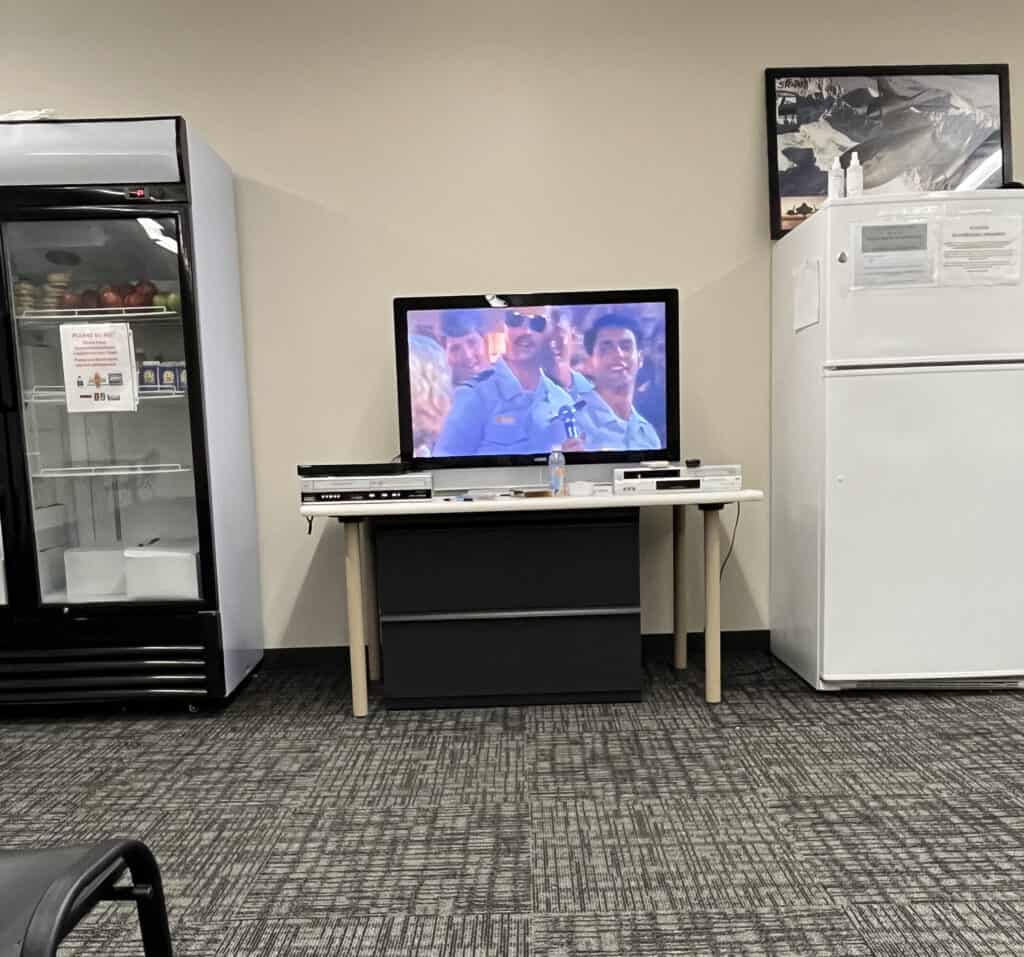
When lunch rolls around ROTC / AD bubbas will eat out of the white cardboard lunchbox in the waiting room fridge (seen in the photo above at the bottom of the left fridge), while Guard and Reserve guys and gals can head upstairs to the cafe and secure a panini, or go off base to get a quick bite. If you go off base I’d recommend getting something quick and bringing it back to eat in the waiting room so you don’t miss your name being called or an opportunity to knock out another requirement.
Day 1 will end at the time your Medical Technician Lead decides (normally around 4-5 PM). If you made friends in the waiting room, exchanging numbers isn’t a bad idea and neither is coordinating somewhere to meet for dinner. It’s doubtful you know anyone else in Dayton, OH to get dinner with anyway. Get dinner, try to call it an early night. Group B should start fasting no later than 7 PM and drinking fluids for your blood draw tomorrow morning.
Day 2:
Day 2 looks a whole lot like Day 1, but the groups are flipped. Group B goes across the street from the Inn for blood work and Group A reports directly to Building 840. Day 2 is chaotic because it’s almost every man for themselves from this point forward. Like yesterday, you start as a group then get singled out for your individual medical evaluations with no real order. This controlled chaos could lead to situations like you having not started your eye exams while your buddies finish everything and get their stamp of approval by Day 2.
Evaluations that are done throughout the days consist of the following:
- Height, Weight, Sitting height measurements: These measurements are easy, self explanatory and out of your control.
- Blood pressure and heart rate: No surprises here, this is standard just like any medical check up. Your FC1 can be an anxious time, so to help reflect good numbers on both your heart rate and blood pressure exams I recommend consuming no caffeine, creatine or supplements within 5 days prior to or during your Flying Class One.
- Hearing: Since everyone prior to an FC1 has to go through Military Entrance Processing Station (MEPS), you’ll know exactly how this exam goes. This evaluation is just like MEPS, but instead of being in a packed room this evaluation is done in a singular noise canceling box that’s no bigger than your standard closet. Mouth breath and try not to psych yourself into hearing the beep.
- Dental: Your dental exam is similar to a standard civilian dental exam minus the teeth cleaning. They will take X-rays.
- Medical records review with Doc: For this part you’ll be taken to a room to discuss with a Doctor all of your previous medical history. Now is not the time to shoot yourself in the foot and mention the Swine Flu scare you had in 2008 or an ankle sprain you had playing 7th grade Football for the first time ever. Truthfully answer any questions asked about what’s in your medical records, and you’ll make it out just fine. If you have something you’d like to discuss with a medical professional prior to this your Flying Class One, I would recommend looking into the BogiDope Military/FAA Medical Consultation which is a 45-minute medical consultation with BogiDope’s Aeromedical division. Our aeromedical professionals offer extensive experience and knowledge with military & FAA aviation medical requirements as well as the inner workings of medical waivers. All calls are 100% confidential and independent of the Air Force or FAA.
- Optometry: This subject is multifaceted. There are going to be more eye exams done to you throughout your time at your FC1 than you even knew existed. Be prepared for a dilation, traditional vision exam corrected and non corrected to 20/20, color vision exam, lens topography measurement, eye laser measurement, the same depth perception exam done at MEPS, eye pressure test, a scan of the back of your cornea and more. Also if you cannot pass the non-corrected 20/20 vision exam or the depth perception the first time around, you’ll even be issued some sweet new spectacles from the Doc (photo below). I had friends fly through optometry in 1-2 hours while I took probably 7-8 hours over the course of 2 days. Everyone’s eyes are different.

- Electrocardiogram (EKG): You’ll get taken into a medical room and get about a dozen electrodes stuck to you to measure things like how fast the heart is beating, the rhythm of the heart beats (steady or irregular), and the strength and timing of the electrical impulses as they move through the different parts of the heart. Once again this is an evaluation out of your control, so just breath.
- Chest X-rays: They will take x-rays of your chest and chest cavity. You won’t hear or see anything about these results unless something out of the ordinary shows up.
- Neuropsychological exam: This evaluation is done in a computer lab with about 25 of your other FC1 peers. If you’ve ever gone to an PSI testing center to take your FAA written exams, this looks alot like those locations. Outdated computers behind a beige fabric cubicle and a set of headphones from the 90’s hung up is an accurate representation for this room. This exam is all online and about 4 hours in duration but split up into four parts with a short break in between. These exams are a combination of a mental health screening, memory test, cognitive thinking test, overall general knowledge test and personality test. Although this exam holds no weight in the final decision of your FC1, it is still important. You also do not want to be the guy that gets questioned why your IQ portion of these exams was so low.
- Final talk with flight Doc: This is your last step. You’ll visit the Flight Doctor one last time after completing all of the evaluations over the past few days. The Doc will start with a standard physical then dive into the results from all of your evaluations and exams. It is important to note if you are recommended for a waiver you won’t get told yes or no officially until your waiver clears the Surgeon General. After this conversation with the Doc you’ll have a good idea what your odds are of an approved FC1.
Day 3-5:
If you have a day 3 or 4 like I did, you’ll find fewer and fewer candidates left as the days pass. You very well could be the only individual left in the waiting room watching a movie alone. Press on through the “We see something we want to run more exams on,” and have hope you’ll get that final approval. Days 3, 4 and 5 if needed are allotted to finishing up any exams or evaluations you have not yet completed.
Whenever your time does come to an end at Wright-Patt or if you’re looking for something to do after being released for the day here are some solid recs:
Dayton, OH Recommendations:
- National Museum of the US Air Force: This museum has enough airplanes and pieces of history in it to keep any aviation enthusiast occupied from open to close of business for 5 days solid. Imagine 4 large classic semi circle hangers packed full with all things aviation and space. Best part: it’s free. They do close early (5 PM) everyday so this can and should be a multi day stop for you. The only piece of advice I have when visiting is to bring your walking shoes and avoid the elementary school field trips.
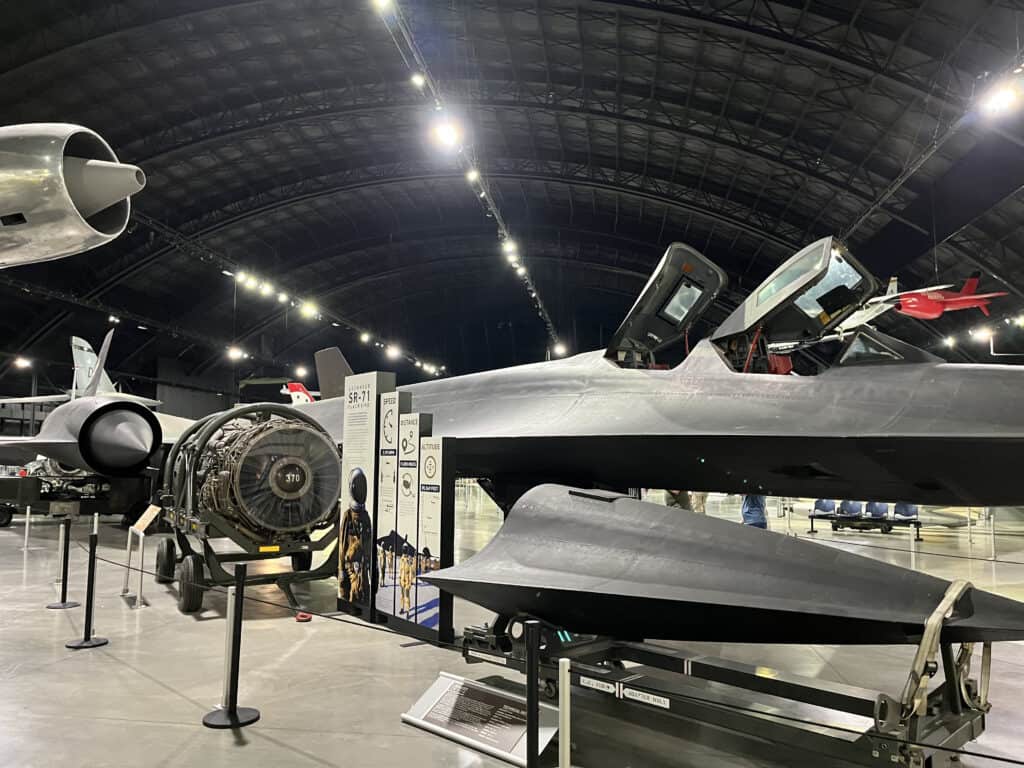

- Texas Roadhouse Tuesday: For some reason a lot of the staff members at WPAFB go to the Texas Roadhouse in Dayton on Tuesday and call this activity “Texas Roadhouse Tuesday”. Coming from Texas I was skeptical, but rallied a group of other FC1 participants and went for dinner. This is a guaranteed good time and meal.
- Golf: This Is hit or miss depending on the time of year you are in Ohio for your FC1. I went in July, and after a group of us passed our Flying Class One, we played a round of golf on WPAFB’s golf course called “Prairie Trace Golf Course”. You can rent clubs for $20 and split them with your partner, then get a cart and play 18 holes for $24. All-in, with the purchase of a sleeve of golf balls since none of us came prepared, this was a relatively cheap good time. The course is also well-maintained and the fairways play pretty straight for novice golfers.

- Go to Cincinnati for a Reds Game: This is also dependent upon the time you are in Dayton, OH for your FC1, but if your orders align with a Cincinnati Reds home game the hour and twenty minute drive to Cincinnati might be worthwhile to catch a Major League Baseball Game.
All in all:
Your Flying Class One can be an incredibly stressful and nerve-racking time. For a lot of candidates everything up until now has been in your control. The Flying Class One strips you of any control and evaluates you on the basis of being “fit to fly” deemed on rigid pre-set standards. Relinquishing all of your control, trusting in the Docs and medical personnel at Wright-Patt, and taking a deep breath is my advice. During my 5th hour of eye exams and 7th Depth Perception evaluation, one of the Optometry Doctors reminded me that during your FC1 it is extremely rare for one exam or evaluation to disqualify you. It almost always has to be a collection of things. This was my first time hearing this. Going into my FC1, I always heard that failing your color vision or depth perception would be an automatic disqualification. This isn’t true, there were several people who had multiple tries at depth perception and my class even had a candidate fail color vision and get re-tested.
If you have any concerns of previous or ongoing medical issues, I would recommend reading the most recent revision of the Air Force Waiver Guide HERE and considering a BogiDope Military/FAA Medical Consultation call HERE.
If you have any questions feel free to direct them to me at Riley@BogiDope.com and if you would like another BogiDope perspective on your FC1 find it HERE.
Goodluck and Godspeed.







